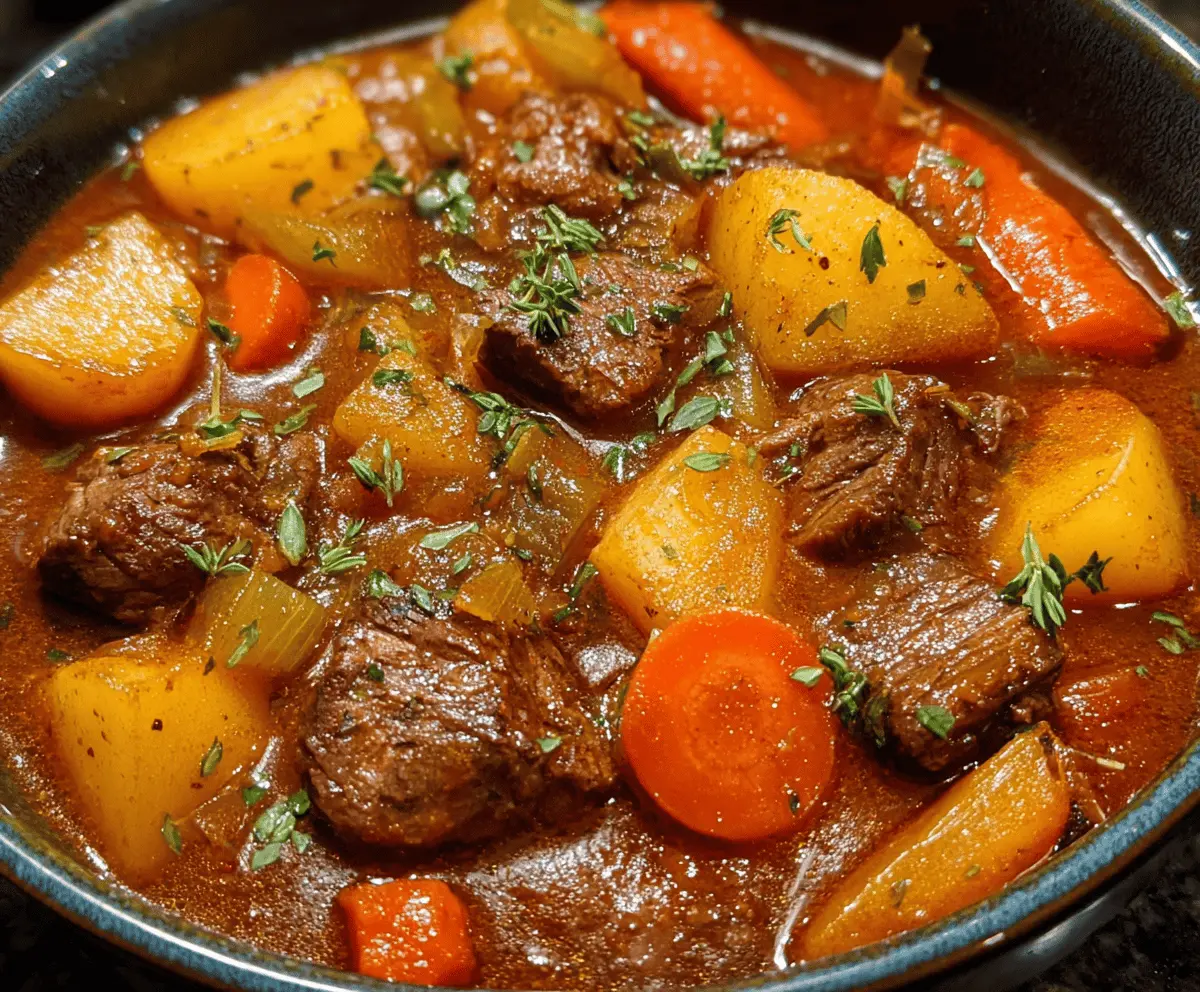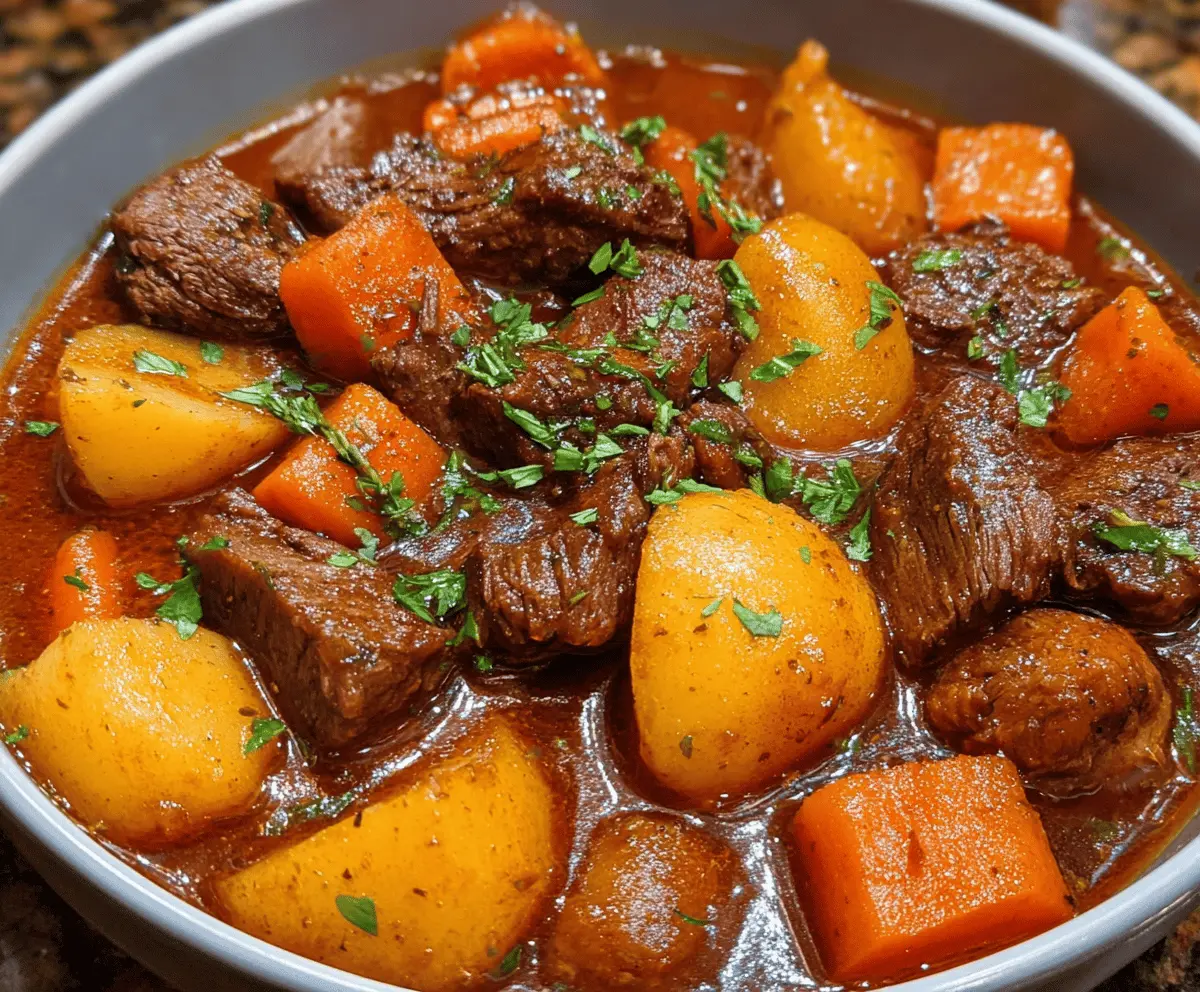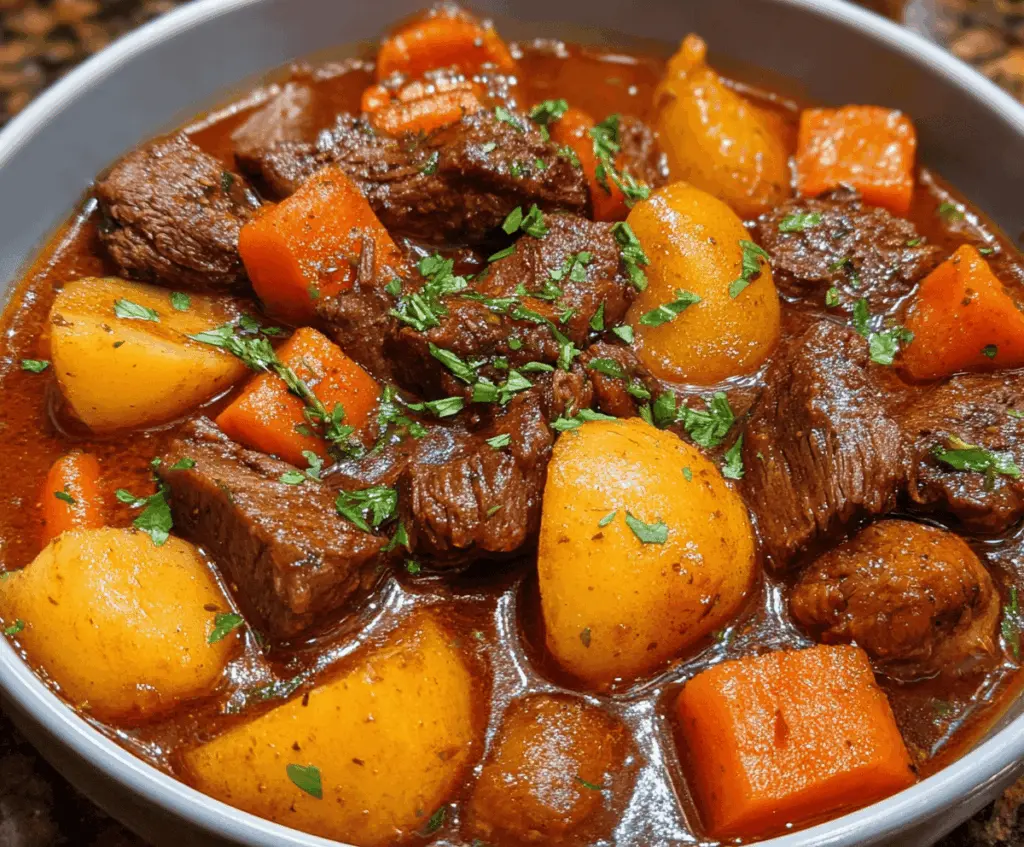Homemade Beef Stew is the kind of dish that feels like a warm hug on a chilly day. It’s packed with tender chunks of beef, hearty potatoes, carrots, and onions all simmered slowly in a rich, flavorful broth. The slow cooking really brings out the deep flavors and makes everything melt-in-your-mouth soft.
I love making this stew when I have a little extra time to let it cook low and slow. That way, the beef becomes super tender and the veggies soak up all those yummy juices. Plus, the kitchen smells amazing while it’s cooking, which always makes me even more excited to eat it!
My favorite way to serve homemade beef stew is with some crusty bread on the side—perfect for soaking up every last bit of broth. It’s the kind of meal that brings people around the table to share stories and laughs. Whenever I make it, it feels like home, simple and satisfying.
Key Ingredients & Substitutions
Beef chuck: This cut is great for stew because it’s flavorful and becomes tender when cooked slowly. If you don’t have chuck, stew beef or brisket can work too, though they might cook a bit differently.
Potatoes and carrots: Use Yukon Gold or red potatoes as they hold shape well. Russets can get mushy. Carrots add sweetness and color—feel free to add parsnips or turnips for a twist.
Tomato paste: It deepens the flavor and adds richness. If you don’t have tomato paste, a small spoon of ketchup or tomato sauce can work, though the taste will be lighter.
Red wine: Optional but adds nice depth. If you skip it, just add more beef broth or even a splash of balsamic vinegar for some acidity.
How Do You Get Tender, Flavorful Beef in Stew?
Patience is key! Here’s what really helps:
- Dry the beef well: Moisture prevents good browning. Use paper towels before seasoning.
- Brown in batches: Overcrowding the pot steams the beef instead of browning it. Take your time and get a nice crust.
- Low and slow simmer: Once liquids are added, keep the heat low and let the beef cook gently for 1.5–2 hours. This breaks down tough fibers and makes it melt in your mouth.
These steps build both flavor and tenderness — no rushed beef stew here!

Equipment You’ll Need
- Large heavy-bottomed pot or Dutch oven: I like this because it evenly cooks the stew and can go from stovetop to oven if needed.
- Browning tongs or slotted spoon: Easy for turning and removing the beef in batches without splattering.
- Cutting board and sharp knife: For chopping your vegetables and cutting the beef into uniform pieces.
- Measuring spoons and cups: Helpful to keep the spices and liquids just right.
- Soup ladle: Perfect for serving the hot stew in bowls.
Flavor Variations & Add-Ins
- Swap beef for lamb or chicken: Use for different flavors; lamb adds richness, chicken makes it lighter.
- Add peas or green beans: Stir in these fresh veggies in the last 10 minutes for extra color and freshness.
- Use different herbs: Try rosemary or basil for a different aromatic profile.
- Include mushrooms: Sauté and add them along with the other vegetables for a earthy taste.

How to Make Homemade Beef Stew
Ingredients You’ll Need:
- 2 pounds beef chuck, cut into 1.5-inch cubes
- 3 tablespoons vegetable oil
- 1 large onion, chopped
- 3 cloves garlic, minced
- 4 cups beef broth
- 2 cups water
- 1 cup red wine (optional, can replace with more beef broth)
- 4 large carrots, peeled and cut into chunks
- 4 medium potatoes, peeled and cut into chunks
- 2 tablespoons tomato paste
- 1 teaspoon dried thyme
- 1 teaspoon dried rosemary
- 2 bay leaves
- Salt and freshly ground black pepper, to taste
- 2 tablespoons all-purpose flour (for dredging beef)
- Fresh parsley, chopped (for garnish)
How Much Time Will You Need?
This stew takes about 20 minutes to prepare, plus around 2 to 2.5 hours to cook slowly. The long simmering time makes the beef tender and lets the flavors blend beautifully.
Step-by-Step Instructions:
1. Prepare and Brown the Beef:
Dry the beef cubes with paper towels, then sprinkle salt and pepper over them. Lightly coat the beef pieces with flour, shaking off any extra. Heat the vegetable oil in a large heavy pot or Dutch oven over medium-high heat. Brown the beef in batches, about 3 to 4 minutes each, making sure to get a good sear on all sides. Remove browned beef and set aside.
2. Cook the Onion and Garlic:
In the same pot, add the chopped onion and cook over medium heat until soft and clear, about 5 minutes. Add the minced garlic and cook for another minute, stirring continuously so it doesn’t burn.
3. Add Tomato Paste and Deglaze:
Stir in the tomato paste and cook for 1 to 2 minutes to deepen its flavor. Pour in the red wine (if using) and scrape up any browned bits stuck to the pot. Let the wine reduce a bit, about 3 to 4 minutes.
4. Simmer the Stew:
Return the browned beef to the pot. Add the beef broth, water, dried thyme, rosemary, and bay leaves. Stir everything together. Bring the stew to a gentle boil, then lower the heat, cover, and let it simmer for 1.5 to 2 hours until the beef is tender.
5. Add Vegetables and Finish Cooking:
Put the chopped carrots and potatoes into the pot. Cover and cook for an additional 30 to 40 minutes, or until the vegetables are soft.
6. Final Touches:
Remove the bay leaves. Taste the stew and add salt and pepper if needed. Serve hot, sprinkled with fresh parsley. This stew pairs wonderfully with crusty bread to soak up all the delicious broth.
Can I Use Frozen Beef for This Stew?
Yes, but make sure to fully thaw the beef in the refrigerator overnight before cooking. Pat it dry thoroughly to ensure good browning and avoid excess moisture in the pot.
Can I Make Beef Stew in a Slow Cooker?
Absolutely! Brown the beef and sauté the onions and garlic first, then transfer everything to your slow cooker. Cook on low for 7-8 hours or on high for 4-5 hours until the beef is tender.
How Do I Store Leftover Beef Stew?
Cool the stew completely, then store it in an airtight container in the refrigerator for up to 3-4 days. You can also freeze it for up to 3 months—thaw overnight in the fridge before reheating.
Can I Substitute the Potatoes with Something Else?
Yes, you can use sweet potatoes, turnips, or parsnips for different flavors and textures. Keep in mind cooking times may vary slightly depending on your choice.



